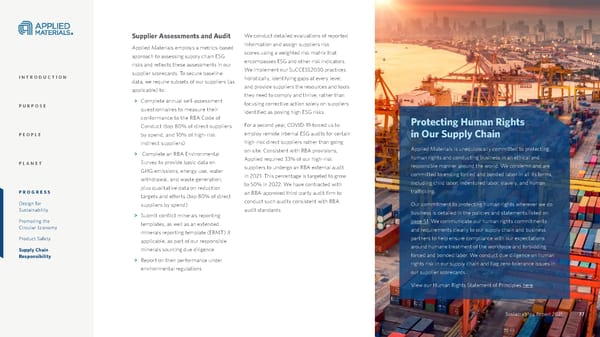Sustainability Report 2021 77 Sustainability Report 2021 Supplier Assessments and Audit Applied Materials employs a metrics-based approach to assessing supply chain ESG risks and reflects these assessments in our supplier scorecards. To secure baseline data, we require subsets of our suppliers (as applicable) to: > Complete annual self-assessment questionnaires to measure their conformance to the RBA Code of Conduct (top 80% of direct suppliers by spend, and 10% of high-risk indirect suppliers) > Complete an RBA Environmental Survey to provide basic data on GHG emissions, energy use, water withdrawal, and waste generation, plus qualitative data on reduction targets and efforts (top 80% of direct suppliers by spend) > Submit conflict minerals reporting templates, as well as an extended minerals reporting template (ERMT) if applicable, as part of our responsible minerals sourcing due diligence > Report on their performance under environmental regulations We conduct detailed evaluations of reported information and assign suppliers risk scores using a weighted risk matrix that encompasses ESG and other risk indicators. We implement our SuCCESS2030 practices holistically, identifying gaps at every level, and provide suppliers the resources and tools they need to comply and thrive, rather than focusing corrective action solely on suppliers identified as posing high ESG risks. For a second year, COVID-19 forced us to employ remote internal ESG audits for certain high-risk direct suppliers rather than going on-site. Consistent with RBA provisions, Applied required 33% of our high-risk suppliers to undergo an RBA external audit in 2021. This percentage is targeted to grow to 50% in 2022. We have contracted with an RBA-approved third-party audit firm to conduct such audits consistent with RBA audit standards. Protecting Human Rights in Our Supply Chain Applied Materials is unequivocally committed to protecting human rights and conducting business in an ethical and responsible manner around the world. We condemn and are committed to ending forced and bonded labor in all its forms, including child labor, indentured labor, slavery, and human trafficking. Our commitment to protecting human rights wherever we do business is detailed in the policies and statements listed on pag e 51 . We communicate our human rights commitments and requirements clearly to our supply chain and business partners to help ensure compliance with our expectations around humane treatment of the workforce and forbidding forced and bonded labor. We conduct due diligence on human rights risk in our supply chain and flag zero-tolerance issues in our supplier scorecards. View our Human Rights Statement of Pri nciples here . Sustainability Report 2021 77 INTRODUCTION PURPOSE PEOPLE PLANET PROGRESS Design for Sustainability Promoting the Circular Economy Product Safety Supply Chain Responsibility
 Applied Materials Sustainability Report Page 76 Page 78
Applied Materials Sustainability Report Page 76 Page 78